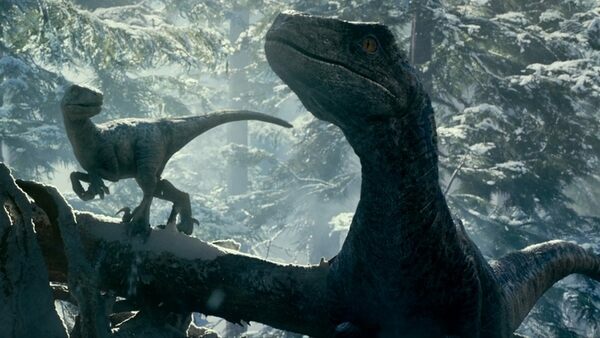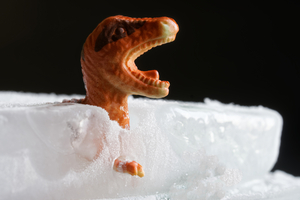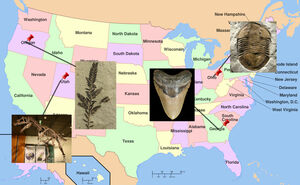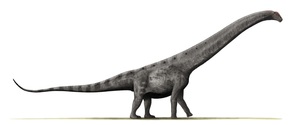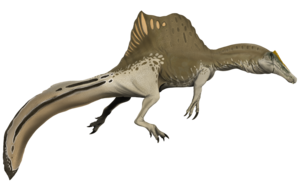Dinosaurs In The Snow, What Are The Facts?
For many, picturing the mesozoic era conjures up images of steamy jungles, smoking volcanoes and tropical islands. The most popular media about the era, or fauna native to it, strongly adheres to this public perception, so it’s only understandable that this misconception persists. For the most part, it isn’t even that inaccurate, much of the Mesozoic was accompanied by a rise in sea levels and temperature, creating “greenhouse” conditions. But the mesozoic era was a 186 million year long geological era spanning from 252 mya to 65 mya, encompassing the entire planet through a myriad of tectonic, oceanic, and climatological shifts. The world was living, breathing, changing and active as much then as it is now, perhaps even moreso.
The organisms that inhabited this ancient earth would have had to adapt to these changes in kind. Excess heat would need to be released in hotter periods, while heat would need to be better retained in colder climes. Dinosaurs, perhaps the most successful vertebrates of the mesozoic era, would certainly not be immune to the changing motions of the planet. Having been found on every continent including Antarctica, dinosaurs would have spanned a range of climates and seasons across every geographic latitude, likely including areas of snow and ice.
But dinosaurs were reptiles, weren’t they? And with little exception, reptiles of the modern day experience great difficulty surviving outside of the tropics. So how did these ancient reptiles fare better than their modern counterparts, and why do we believe that they did? Geographic evidence, histological evidence, and ontogenetic evidence suggest that dinosaurs survived in a multitude of different climates, including snowy, wintery ones.
The Mesozoic era is typically thought of by the general public as being a hotter, wetter Earth than the one we inhabit today. And while at a majority of places and times throughout the mesozoic that would be true, there were many other environments and factors that existed throughout the 186 million year era. The Triassic period, beginning 252 million years ago, marked the beginning of the Mesozoic era and the end of the prior Paleozoic era. The last period of the Paleozoic, the Permian, ended with a mass extinction that led to the death of nearly 70% of all life on land, and 95% of ocean life.
Numerous factors lead to the Permian extinction, one of which was the oppressive heat created by the supercontinent Pangaea. As there was little water running into the center of the landmass, much of the interior of Pangaea was a massive desert. Even through the mid triassic, this continent maintained its connectivity, and thus, much of the Triassic was characterized by dry shrubland with periodic rainy seasons and sandy, sahara-like dunescapes. It was in the post-recovery crucible of the mid-Triassic that the first dinosaurs emerged.
In the time to come, the Earth’s landmasses would split apart, first Laurasia, which would become North America, Europe, and Asia, leaving Gondwana in the southern hemisphere. Gondwana would break apart to form South America, Africa, Australia, and Antarctica. The new circulation of ocean water combined with rising sea levels created a much more humid world, and created the greenhouse conditions that are popularly associated with the time period.
Still, as is the case today, temperatures fell towards the poles, although throughout the Jurassic and Cretaceous it was thought that carbon in the atmosphere decreased the variance in temperature across latitudinal boundaries. Additionally, by the end of the Cretaceous period, a cooling period began taking place, a trend which would continue even after the non-avian dinosaurs had gone extinct. This cooling period would create climate conditions similar to those of today, restricting the tropics to the equator and emphasizing seasonal disparity in more temperate climates. Throughout the Mesozoic, the conditions for snow and wintry climes existed, if sparsely at times, on many parts of the planet. In addition, we have fossil evidence of dinosaur remains across an extreme range of latitudes, with discoveries in locales such as Alaska and Antarctica.
Perhaps some of the best evidence for some dinosaurs inhabiting wintry wonderlands is their presence in polar regions. Particularly, southwest Australia, New Zealand, Alaska, and Antarctica. Fossilized plants from the North Slope of Alaska indicate a temperature averaging slightly warmer than today, with average minimums of 36-46 degrees fahrenheit and maximums of about 55 degrees. There are no reptile or crocodilian remains found here, but there are non-avian dinosaurs. Additionally, there is no evidence to suggest that the axis of the Earth has shifted significantly since then, meaning dinosaurs would have faced the same long days and nights that characterize life close to the poles. Feathered dinosaurs found in the area seem to support that endothermic dinosaurs were very much the norm, at least by the Cretaceous period. Nanuqsaurus, a smaller relative of Tyrannosaurus from Alaska, was found on the North Slope and aged to about 69 million years ago, close to the end of the Mesozoic. Nanuqsaurus was a large predator, so naturally it wasn’t the only large animal in its environment. It shared its cold climate with the large hadrosaurids Ungrunaaluk and Edmontosaurus, and the ceratopsian Pachyrhinosaurus. If not all dinosaurs were endotherms, the evidence at the very least strongly suggests these species as being endothermic. And since Nanuqsaurus is a saurischian dinosaur, and Edmontosaurus and Pachyrhinosaurus are ornithischian dinosaurs, it is more likely that endothermy is ancestral to the earliest dinosaurs than it is likely that each group evolved endothermy independently.
Smaller species, too, have been found here at the North Slope. A birdlike troodontid dubiously assigned to the Troodon genus has been found in the area, as well as dromaeosaurs such as Saurornitholestes and Dromaeosaurus. The small herbivores Orodromeus and Alaskacephale are also known from this area. This shows us that a wide range of different sized dinosaurs inhabited this cold, arctic habitat. While certainly not conclusive evidence towards warm-bloodedness in dinosaurs, it is difficult to picture cold blooded ectothermic reptiles surviving well in these higher latitudes. A lack of fossil evidence of other non-dinosaurian reptiles seems to support this conclusion as well.
Moving to the South Pole, many dinosaur remains, albeit fragmentary or partial, have been found in Antarctica and Australia, which have shifted through the Earth’s south polar region over millions of years due to tectonic shifts. About 100 million years ago, during the mid to late Cretaceous, much of the southeastern half of Australia was completely within the Antarctic circle, while Antarctica shifted into that position as Australia moved northward. Many of the remains found here have been hard to identify, due to their poor preservation, but their existence in those locations at those times is indisputable. The topic of glaciation and ice cover during the era is contested, but there is thought to have been some permanent ice coverage over at least some of this geographic era. Much of the region would have been seasonal or temperate, but would have polar winters ranging from 6 weeks to 4 months. Some dinosaurs from Antarctica, such as Leallynasaurus, show larger than average eye sockets. Additionally, studies of the bone structure of Leallynasaurus’ relatives, who also lived in the area, indicate that the bones grew constantly throughout the animal’s life, indicating it did not hibernate through the colder season.
Sauropods are also known from Australia, with three titanosaurs and one macronarian (of the same family that included the more well known brachiosaurus). Their remains have not been found in the polar region, southeastern Australia, however these Titanosaurs, whose ancestors originated in South America and Africa, must have migrated through Antarctica and southeastern Australia to reach their final habitat, so they must have lived within those colder climes, at least interstitially.
In nature, a wide variety of animals can survive in seasonal and polar environments, but the vast majority of them are endothermic, or “warm-blooded”. Some ectothermic, or “cold-blooded” organisms do live in colder environments, but have developed specific behaviors or physiological adaptations to aid in their survival. Snakes and turtles engage in brumation, essentially the reptilian version of mammalian hibernation. Alligators living in the northernmost edges of their natural range will do this as well, keeping their snouts above water as the ice freezes around them. Would dinosaurs, being reptiles, have engaged in similar behaviors? Or would they have found other ways to over-winter? If they were in fact ectotherms, they would have had difficulties maintaining activity in cooler climates. Meanwhile, if they were endothermic, they would have had an easier time surviving, but would face different challenges maintaining active lifestyles in low temperatures.
Ectotherms generally do poorly in cold environments, and those that do inhabit colder regions typically avoid intensive activity. Endotherms can inhabit colder environments without much difficulty, but use much more energy doing so than ectotherms. They need to eat a much greater proportion of food to maintain their internal temperature and keep themselves alive. For large animals like dinosaurs, this would be quite difficult in a sparser, more wintry environment, but geographic fossil evidence suggests that both small and large dinosaurs still thrived in colder regions regardless.
One theory as to how dinosaurs may have maintained internal temperature is a unique form of heat generation called “gigantothermy”. This idea suggests that giant dinosaurs may have maintained a higher body temperature by virtue of their bulk alone. In basic terms, when an object, in this case a large dinosaur, doubles in surface area, its volume increases by a factor of 8. This means that there is less of the animal’s total mass exposed to the outside air, which means that it loses less of its internal temperature to the surrounding environment. Some large sauropods have been found in Australian strata, which brings up the possibility that they may have existed in a cooler climate than typically envisioned. If this is the case, then perhaps gigantothermy may have aided in keeping the giants alive. However, this would not have explained the presence of smaller dinosaurs in colder regions, or the juvenile specimens of large dinosaurs.
In light of this, some instead point to histological evidence. Researching sections of fossilized dinosaur bone, scientists have found evidence both for and against endothermy. Lines of Arrested Growth, or LAGs are found in the scant remains of the theropod Timimus, found in Australia and dated to a time when the continent was located around the south pole. These LAGs are found in modern reptiles and are typically associated with low metabolic rates, typical of ectothermic animals. And yet, Timimus was found in polar Australia. Some have suggested that this could represent evidence that Timimus hibernated, or perhaps brumated in the long winter night of the area. The contemporaneous herbivore, Leaellynasaura, which also inhabited the region, does not show signs of these LAGs in its fossil material. This, coupled with the species’ larger than average eye sockets, have made some scientists believe that the species maintained activity over the cold polar winter. No matter which is correct, it is undoubtedly true that both of these species experienced far colder conditions than the majority of today’s reptiles, and both would have experienced snowfall in some capacity.
Paleontology is an ever-evolving science, and dinosaurs will always be a continual point of interest. As one of the most successful land vertebrate groups to ever live, we can learn so much about what shapes success and ecologies in the modern world from their existence. And while our original understanding of them in the 19th century was far more limited, we now know from fossil evidence that there wasn’t a place on Earth where dinosaurs could not tread.
Price, Gregory D. (1999). “The evidence and implications of polar ice during the Mesozoic” Earth-Science Reviews. 48 (3): 183-210
Druckenmiller, Patrick S., Erickson, Gregory M., Brinkman, Donald; Brown, Caleb M., Eberle, Jaelyn J. (2021). "Nesting at extreme polar latitudes by non-avian dinosaurs". Current Biology. 31 (16): 3469–3478.
Poropat, S. F.; Mannion, P. D.; Upchurch, P.; Hocknull, S. A.; Kear, B. P. (2016). "New Australian sauropods shed light on Cretaceous dinosaur palaeobiogeography". Scientific Reports. 6 (34467): 34467.
Benson, R. B., Rich, T. H., Vickers-Rich, P., & Hall, M. (2012). Theropod fauna from southern Australia indicates high polar diversity and climate-driven dinosaur provinciality. PloS one, 7(5), e37122.
Seymour, Roger S. (2013-07-05). "Maximal Aerobic and Anaerobic Power Generation in Large Crocodiles versus Mammals: Implications for Dinosaur Gigantothermy". PLOS ONE. 8 (7): e69361.
Fiorillo, A. R., & Tykoski, R. S. (2014). A diminutive new tyrannosaur from the top of the world. PloS one, 9(3), e91287.
The organisms that inhabited this ancient earth would have had to adapt to these changes in kind. Excess heat would need to be released in hotter periods, while heat would need to be better retained in colder climes. Dinosaurs, perhaps the most successful vertebrates of the mesozoic era, would certainly not be immune to the changing motions of the planet. Having been found on every continent including Antarctica, dinosaurs would have spanned a range of climates and seasons across every geographic latitude, likely including areas of snow and ice.
But dinosaurs were reptiles, weren’t they? And with little exception, reptiles of the modern day experience great difficulty surviving outside of the tropics. So how did these ancient reptiles fare better than their modern counterparts, and why do we believe that they did? Geographic evidence, histological evidence, and ontogenetic evidence suggest that dinosaurs survived in a multitude of different climates, including snowy, wintery ones.
Climate In The Mesozoic
The Mesozoic era is typically thought of by the general public as being a hotter, wetter Earth than the one we inhabit today. And while at a majority of places and times throughout the mesozoic that would be true, there were many other environments and factors that existed throughout the 186 million year era. The Triassic period, beginning 252 million years ago, marked the beginning of the Mesozoic era and the end of the prior Paleozoic era. The last period of the Paleozoic, the Permian, ended with a mass extinction that led to the death of nearly 70% of all life on land, and 95% of ocean life.
Numerous factors lead to the Permian extinction, one of which was the oppressive heat created by the supercontinent Pangaea. As there was little water running into the center of the landmass, much of the interior of Pangaea was a massive desert. Even through the mid triassic, this continent maintained its connectivity, and thus, much of the Triassic was characterized by dry shrubland with periodic rainy seasons and sandy, sahara-like dunescapes. It was in the post-recovery crucible of the mid-Triassic that the first dinosaurs emerged.
In the time to come, the Earth’s landmasses would split apart, first Laurasia, which would become North America, Europe, and Asia, leaving Gondwana in the southern hemisphere. Gondwana would break apart to form South America, Africa, Australia, and Antarctica. The new circulation of ocean water combined with rising sea levels created a much more humid world, and created the greenhouse conditions that are popularly associated with the time period.
Still, as is the case today, temperatures fell towards the poles, although throughout the Jurassic and Cretaceous it was thought that carbon in the atmosphere decreased the variance in temperature across latitudinal boundaries. Additionally, by the end of the Cretaceous period, a cooling period began taking place, a trend which would continue even after the non-avian dinosaurs had gone extinct. This cooling period would create climate conditions similar to those of today, restricting the tropics to the equator and emphasizing seasonal disparity in more temperate climates. Throughout the Mesozoic, the conditions for snow and wintry climes existed, if sparsely at times, on many parts of the planet. In addition, we have fossil evidence of dinosaur remains across an extreme range of latitudes, with discoveries in locales such as Alaska and Antarctica.
Dinosaurs In The Snow: Which Kinds Were There?
Perhaps some of the best evidence for some dinosaurs inhabiting wintry wonderlands is their presence in polar regions. Particularly, southwest Australia, New Zealand, Alaska, and Antarctica. Fossilized plants from the North Slope of Alaska indicate a temperature averaging slightly warmer than today, with average minimums of 36-46 degrees fahrenheit and maximums of about 55 degrees. There are no reptile or crocodilian remains found here, but there are non-avian dinosaurs. Additionally, there is no evidence to suggest that the axis of the Earth has shifted significantly since then, meaning dinosaurs would have faced the same long days and nights that characterize life close to the poles. Feathered dinosaurs found in the area seem to support that endothermic dinosaurs were very much the norm, at least by the Cretaceous period. Nanuqsaurus, a smaller relative of Tyrannosaurus from Alaska, was found on the North Slope and aged to about 69 million years ago, close to the end of the Mesozoic. Nanuqsaurus was a large predator, so naturally it wasn’t the only large animal in its environment. It shared its cold climate with the large hadrosaurids Ungrunaaluk and Edmontosaurus, and the ceratopsian Pachyrhinosaurus. If not all dinosaurs were endotherms, the evidence at the very least strongly suggests these species as being endothermic. And since Nanuqsaurus is a saurischian dinosaur, and Edmontosaurus and Pachyrhinosaurus are ornithischian dinosaurs, it is more likely that endothermy is ancestral to the earliest dinosaurs than it is likely that each group evolved endothermy independently.
Smaller species, too, have been found here at the North Slope. A birdlike troodontid dubiously assigned to the Troodon genus has been found in the area, as well as dromaeosaurs such as Saurornitholestes and Dromaeosaurus. The small herbivores Orodromeus and Alaskacephale are also known from this area. This shows us that a wide range of different sized dinosaurs inhabited this cold, arctic habitat. While certainly not conclusive evidence towards warm-bloodedness in dinosaurs, it is difficult to picture cold blooded ectothermic reptiles surviving well in these higher latitudes. A lack of fossil evidence of other non-dinosaurian reptiles seems to support this conclusion as well.
Moving to the South Pole, many dinosaur remains, albeit fragmentary or partial, have been found in Antarctica and Australia, which have shifted through the Earth’s south polar region over millions of years due to tectonic shifts. About 100 million years ago, during the mid to late Cretaceous, much of the southeastern half of Australia was completely within the Antarctic circle, while Antarctica shifted into that position as Australia moved northward. Many of the remains found here have been hard to identify, due to their poor preservation, but their existence in those locations at those times is indisputable. The topic of glaciation and ice cover during the era is contested, but there is thought to have been some permanent ice coverage over at least some of this geographic era. Much of the region would have been seasonal or temperate, but would have polar winters ranging from 6 weeks to 4 months. Some dinosaurs from Antarctica, such as Leallynasaurus, show larger than average eye sockets. Additionally, studies of the bone structure of Leallynasaurus’ relatives, who also lived in the area, indicate that the bones grew constantly throughout the animal’s life, indicating it did not hibernate through the colder season.
Sauropods are also known from Australia, with three titanosaurs and one macronarian (of the same family that included the more well known brachiosaurus). Their remains have not been found in the polar region, southeastern Australia, however these Titanosaurs, whose ancestors originated in South America and Africa, must have migrated through Antarctica and southeastern Australia to reach their final habitat, so they must have lived within those colder climes, at least interstitially.
Dinosaurs In The Snow: How Did They Make It Work?
In nature, a wide variety of animals can survive in seasonal and polar environments, but the vast majority of them are endothermic, or “warm-blooded”. Some ectothermic, or “cold-blooded” organisms do live in colder environments, but have developed specific behaviors or physiological adaptations to aid in their survival. Snakes and turtles engage in brumation, essentially the reptilian version of mammalian hibernation. Alligators living in the northernmost edges of their natural range will do this as well, keeping their snouts above water as the ice freezes around them. Would dinosaurs, being reptiles, have engaged in similar behaviors? Or would they have found other ways to over-winter? If they were in fact ectotherms, they would have had difficulties maintaining activity in cooler climates. Meanwhile, if they were endothermic, they would have had an easier time surviving, but would face different challenges maintaining active lifestyles in low temperatures.
Ectotherms generally do poorly in cold environments, and those that do inhabit colder regions typically avoid intensive activity. Endotherms can inhabit colder environments without much difficulty, but use much more energy doing so than ectotherms. They need to eat a much greater proportion of food to maintain their internal temperature and keep themselves alive. For large animals like dinosaurs, this would be quite difficult in a sparser, more wintry environment, but geographic fossil evidence suggests that both small and large dinosaurs still thrived in colder regions regardless.
One theory as to how dinosaurs may have maintained internal temperature is a unique form of heat generation called “gigantothermy”. This idea suggests that giant dinosaurs may have maintained a higher body temperature by virtue of their bulk alone. In basic terms, when an object, in this case a large dinosaur, doubles in surface area, its volume increases by a factor of 8. This means that there is less of the animal’s total mass exposed to the outside air, which means that it loses less of its internal temperature to the surrounding environment. Some large sauropods have been found in Australian strata, which brings up the possibility that they may have existed in a cooler climate than typically envisioned. If this is the case, then perhaps gigantothermy may have aided in keeping the giants alive. However, this would not have explained the presence of smaller dinosaurs in colder regions, or the juvenile specimens of large dinosaurs.
In light of this, some instead point to histological evidence. Researching sections of fossilized dinosaur bone, scientists have found evidence both for and against endothermy. Lines of Arrested Growth, or LAGs are found in the scant remains of the theropod Timimus, found in Australia and dated to a time when the continent was located around the south pole. These LAGs are found in modern reptiles and are typically associated with low metabolic rates, typical of ectothermic animals. And yet, Timimus was found in polar Australia. Some have suggested that this could represent evidence that Timimus hibernated, or perhaps brumated in the long winter night of the area. The contemporaneous herbivore, Leaellynasaura, which also inhabited the region, does not show signs of these LAGs in its fossil material. This, coupled with the species’ larger than average eye sockets, have made some scientists believe that the species maintained activity over the cold polar winter. No matter which is correct, it is undoubtedly true that both of these species experienced far colder conditions than the majority of today’s reptiles, and both would have experienced snowfall in some capacity.
Paleontology is an ever-evolving science, and dinosaurs will always be a continual point of interest. As one of the most successful land vertebrate groups to ever live, we can learn so much about what shapes success and ecologies in the modern world from their existence. And while our original understanding of them in the 19th century was far more limited, we now know from fossil evidence that there wasn’t a place on Earth where dinosaurs could not tread.
 Reviews
Reviews
